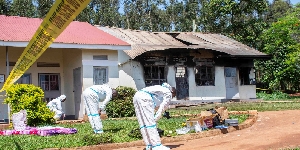 Forensic police officers in front of a burnt dormitory at Salama School for the Blind in Luga,Mukono
Forensic police officers in front of a burnt dormitory at Salama School for the Blind in Luga,Mukono
The government has issued fire safety guidelines that it said schools should implement to prevent and handle fire outbreaks.
Before they reopen for First Term, schools according to the latest guidelines issued by the National Building Review Board (NBRB) should, among others, ensure they all have functioning fire extinguishers, install fire and smoke detectors, fire horse reels, avail emergency exits well labelled, improved roofing, fire hydrants, among others.
The Executive Secretary of the NBRB, Ms Flavia G. Bwire, told journalists on January 29 that many schools are prone to fires because they have not put in place adequate fire-fighting measures.
“The NBRB has since 2020 investigated different fires in schools and found out that the incidents that have resulted in deaths in schools are common, [whereby] all dormitories were crowded, presence of combustible materials, no automatic fire detector or alarm system, and some schools lacked firefighting equipment,” she said.
Ms Bwire added: “There was inconsiderate use of burglar proofing with regard to life safety, lack of knowledge on fire safety and emergency response, inaccessible dormitories and lack of emergency exits.”
Many schools have in the last five years experienced fire outbreaks leading to deaths, with the recent one being Kasana Junior School in Masaka City, which claimed the lives of seven pupils and injured five others on October 29, 2023.
The 2022 Annual Police Report indicated that 40 schools were burnt, with 17 of them being set ablaze deliberately by unknown individuals.
Ms Bwire said the Board with other partners including police, officials from the Gender ministry, Kampala Capital City Authority (KCCA) and members of the Private Educational Institution Association in Uganda (NAPEIA), carried out a one-year investigation in 120 schools (60 government and 60 private) on school fires between May 2022 and May 2023.
Their findings, she said, pointed out critical causes of fires and why schools don’t manage them.
“Only three schools had carried out fire safety assessment by the time of the survey. None of the schools had a fire hydrant on site for fire emergencies and 30 percent installed fire detection and alarm systems, although they did not have adequate coverage,” Ms Bwire said.
Findings of the study further show that 13 percent of the dormitories in the 120 schools were beyond the occupancy limit, “in fact, one of the dormitories was found with an excess of over 70 pupils”.
Ms Bwire said: “We now direct the building committees and building control officers to ensure that all schools within their jurisdictions are inspected and issued with a certificate of inspection as provided for under the Building Control Regulation 2020.”
The Chairperson of NAPEIA, Mr Hasadu Kirabira, yesterday told this publication that schools are already implementing some of the guidelines.
“We carried out a sensitisation campaign in December in western and central Uganda and visited 121 schools where we urged members to install critical measures like fire extinguishers…We have also tasked schools to train fire safety officers,” he said.
Affected schools
•Kasana Junior, Masaka
•Kamuli Girls Primary
•Kisubi Girls Primary, Entebbe Wakiso
•Masaka Secondary School
•Greenhil Junior, Mityana
•Salama School for Blind,Mukono